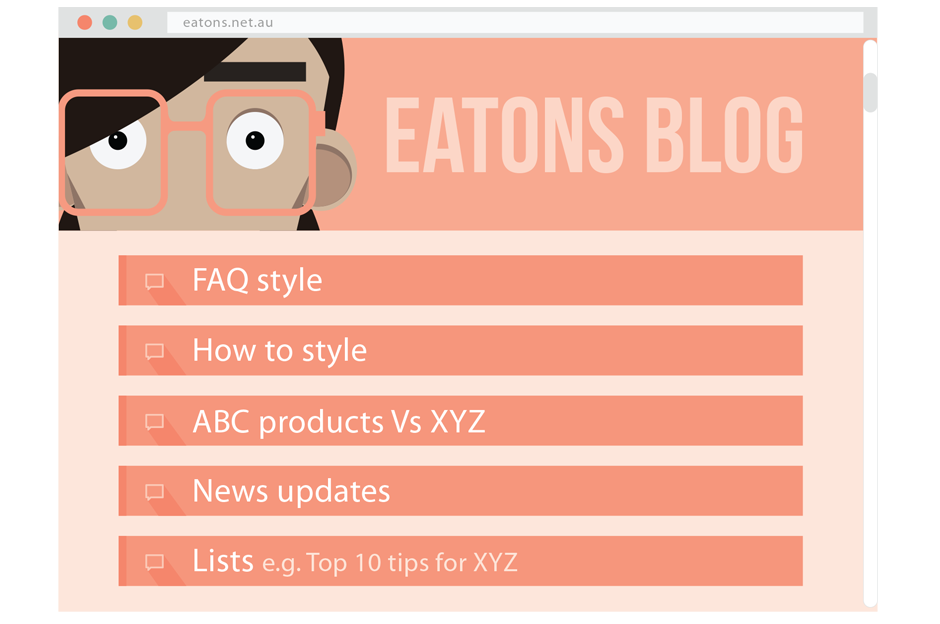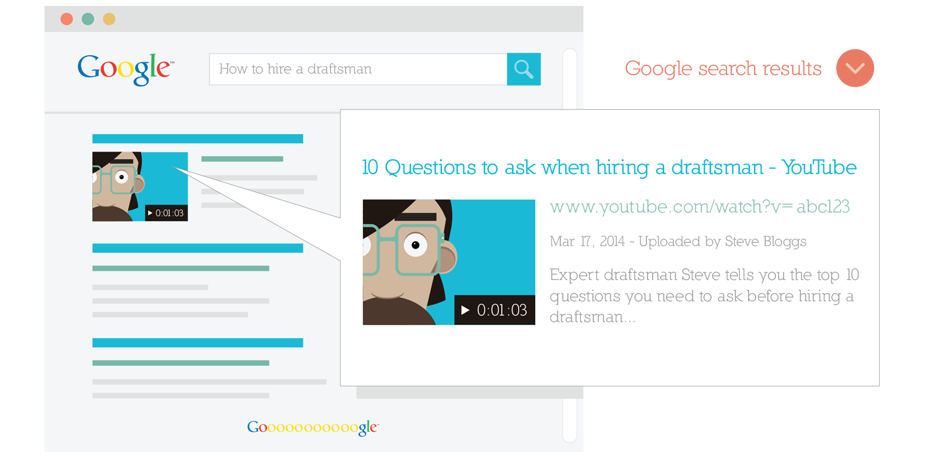Building Awesome Website Content
Building Awesome Website Content
Website Content: Steve the story teller
Steve is a very talented draftsman. He focuses on a helping customers design ‘creative house renovations and extensions’. At the start he had a simple website that explained who he was and what he did. The site consisted of around five pages in total. It didn’t appear in the search engines for any keywords and delivered very few leads and enquiries.
After rebuilding the website in WordPress and setting up a blog Steve got inspired to share his wealth of building and design knowledge. He added one blog post every week for a year. That meant 52 new pages on a range of different topics from house design challenges, building inspiration, renovations, buying and selling, budgeting, sustainability, the list goes on. All categorised and methodically labelled, tagged and optimised.
Looking at his website statistics in Google Analytics (a free-to-use advanced analytical tool provided by Google) it appears that over 75% of his website traffic is derived from searches in Google. In practical terms this equates to over 20,000 unique, highly qualified visitors to his website every year.
In fact, Steve got really specific and did a 15-minute screencast (a digital recording of his screen with audio narration) on a client’s house project he was working on. It walks visitors through in-depth details of the projects challenges, process and design solution.
His site ranks on the first page of Google for keywords such as ‘drafting services Melbourne’ and ‘residential building designers’. These may seem like very specific search terms but this highlights the power of ‘long tail’.
Long tail searches
The term ‘long tail search’ refers to a search phrase that consists of three or more keywords (multi-part keyword). They are typically focused on specific queries and these types of searches make up the majority of the search traffic in Google.
Focusing your efforts on specific longer tail searches can have an incredible return on investment as it drives very targeted, highly qualified traffic. The customer knows exactly what they want which is what they type into Google. The visitor is likely to land on your website, find precisely what they need and are more likely to get in touch.
The added benefit is that there is much less competition for these keywords. The end result is that a long tail search results in more quality website traffic which adds up to lots of unique visitors to your website.
Take Steve the draftsman for example, it is much easier to rank in Google for ‘drafting services Melbourne’” than it is to rank for ‘draftsman’.
Content is king
Gone are the days when you could knock together a five-page website and expect it to be placed in the number one position of Google for your chosen keywords.
Your website will only rank in Google if it deserves to rank.
The new business paradigm is one of openness and transparency. Every business owner is sitting on a mountain of knowledge. You have a breadth of knowledge that your customers are in awe of. There are two options.
You can protect this information and only provide it to people who pay you for it.
Alternatively, you can openly and proactively share and distribute as much information about your business, industry, processes and techniques.
In the age of the search engine which do you think is the better approach?
Relevant, useful content
What is the point of creating all this content? How will it be found, I hear you asking. One word.
Google.
Google is super clear on what it wants – good quality website content that is useful to a visitor. The enduring impact of adding great website content on a regular basis to your website is that you boost the chances of getting found in Google.
Focus on what real people are looking for
Over the years Google has been fine tuning its search algorithm to get rid of all the over manipulated, thinly veiled websites. It only wants one thing; great content. It you can’t provide it with great quality content, then you won’t be found. It is as simple as that.
Quoting Matt Cutts, the head of search at Google, “Good search engine optimisation can also mean good marketing: thinking about creative ways to make a site more compelling, which can help with search engines as well as social media. The net result of making a great site is often greater awareness of that site on the web, which can translate into more people linking to or visiting a site.”
In short, make good website content, get found. This approach is called ‘content marketing’.
There is a huge audience out there for just about every topic you can imagine.
So what exactly is content marketing?
The world has become on-demand. People have zero tolerance for anything shoved down their throat. Customers bombarded with ‘push marketing’ have tuned out. Content marketing is the process of creating informative material that is valuable to attract potential target customers. It is done with the aim of getting user engagement and loyalty which will eventually lead to future sales activity.
A big part of this process is the engagement you can get with prospective customers. If you create something interesting and of value you build trust and rapport. Typically it is education based and shows the reader how to think about a specific topic. It usually comes in the format of a blog post, article, white paper, social media, audio or video. The best type of content is something they have never seen before and leaves them wanting more. The aim is get the prospect to know, like and trust you. The by-product of all this is brand awareness.
Ideas for creating great content
So this all sounds great. But I hear you thinking, “I have nothing to say”.
This is wrong!
Sure, it may seem like a challenge to find things to write about that are interesting and engaging but everyone is closer than they think. Below are 7 tips to get things started:







Use Google for ideas
Google Analytics and Webmaster tools

On the simplest level, Google Analytics tells you how a user is interacting with your current website. It can be used to try to learn as much as possible about your current visitors and what they are looking for. How they are finding it and what they are interacting with.
Look for where they enter your website, which pages convert better than others and the path they take through the website. If certain content gets more traffic, write more of this type of information.
Webmaster tools will list all the keywords that your website is currently ranking for and the click through rates.
Google search results
Here is a great tip. Go to Google and type in a search phase, for example ‘house extension ideas’.
Scroll to the bottom of the page and you will see this:

These are other search phrases that Google deems associated to the current phrase. Related searches are all additional ideas for website content that can be created in the future. Each of the above phrases could be turned into further ideas for blog posts.
Now that you have ideas for your content, the next step is to get outputting!
Put all this great content in a blog
All these ‘posts’ (blog posts) are going to relate to a prospect’s question, for example “What is the difference between an architect vs draftsman.” These posts will get indexed in Google and get your site found. This can then result in a lead or an enquiry for your business. The best thing is that the majority of these types of searches are predominantly highly qualified. Make sure you can answer every long tail phrase you can possibly think of using the ideas listed and you will have dominance online.

Sample formats of website content include:
- FAQ style
- ‘How to’ style
- ABC product vs XYZ product
- News updates
- Lists, for example Top 10 tips for XYZ.
Use video
Video on the web is exploding. Youtube.com is now the world’s second largest search engine and is the first point of call for anyone trying to figure out how to do anything.
The barriers to entry for any business owner to record and produce a video have never been so low. Most people have a smartphone in their pocket which is more than capable of shooting a two-minute high definition video that they can upload to youtube.com and publish on their website. All in five minutes flat.
What if you don’t want to be in front of the camera?
No problem, you can record a video presentation or walk through on your computer screen and have an audio voiceover (known as screen capture).
 Oi, take note! – Screencasting software allows you to create high quality video tutorials, training and presentations. For Mac try ScreenFlow (https://www.telestream.net/screenflow) or PC try Camtasia (https://www.techsmith.com/camtasia.html)
Oi, take note! – Screencasting software allows you to create high quality video tutorials, training and presentations. For Mac try ScreenFlow (https://www.telestream.net/screenflow) or PC try Camtasia (https://www.techsmith.com/camtasia.html)
Sound all too hard? Not in the slightest. First though, let’s start with why video is so powerful.
The power of video
Video is the perfect way to look your prospects in the eye and talk to them direct. You can’t hide behind fancy graphics and design. You are in plain view for all to see.
Most business owners are very good at converting a prospect when they get them on the phone. In a similar approach prospects have the ability to get to know you on a much more intimate level. People feel they can trust you as they have seen you for who you are, a likeable, approachable and trustworthy person who is helping to try and solve their problems.
By putting yourself in plain view you are building trust and rapport and laying the groundwork for the sale. When the prospect is ready to reach out and get in touch, they feel that they already know you. The conversation just tends to flow. Not as much time is required to build a bond and it is a much quicker path to a sale.
Another benefit is that user engagement is much higher. Visitors will spend more time on a website that contains video. You can show off your personality as a business, further deepening the connection with your audience.
Video is a huge leverage point in most businesses which is often under utilised.
The video that you create once can then sell for you on your website over and over again (this is called evergreen content). You as an individual can be replicated many times over. Can you imagine trying to give that same presentation day in day out in person?
It is much quicker to produce once you have a production system in place compared to writing a blog post. All you need to do is think it and say it!
Oh, and Google love video
The barriers to entry are a little higher when it comes to video due to the added steps required to create it.
Therefore Google holds websites that contain it in much higher regard and assign more value to your posts.
The other great thing is Google actually provide videos in their search results which have a much higher click through as the thumbnail attracts the searcher’s eyes. This helps drive targeted traffic to your content.

Video can be repurposed
Due to the simple fact that a video contains both text and visuals, it can be repurposed. This means that by recording a video once, audio and text can be created as a by-product. The audio can be stripped and converted to a podcast. In addition, audio can also be transcribed by physically typing out the text which was just spoken. As Google’s primary focus is still text-based search, by recording the video you have just created lots of great keyword-rich content which will get you found.
5 Video tips:





Build an email list
Say your office was burnt down in a freak fire. Horrible prospect, I know. But think for a moment; what is the one thing that you would want to salvage or hope to recover?
Did I hear you say, “your customer database”?
Bingo! You got it.
This is the information you know about your customers and prospects. (Ideally this is backed up in the cloud somewhere so even if your office was a charred ruin you would still be fine!)
This knowledge about your customers and prospects is an extremely valuable asset. It charts the course for your future sales and marketing activities, the future growth, the lifeblood of your business.
Your customers are people who are already doing business with you and are in your system. We want to build a list of very targeted, segmented prospects to start to form a relationship with. A list of people who have expressed some level of interest in our products of services.
What is the best way of building a list through your website?
You need to wave a carrot.
Give away something of extreme value, for free. Deliver a gold nugget up front and prospects will be blown away by your generosity. It is the best way to start a relationship. The key is to ensure it is useful to the prospect.
In exchange, we will ask for their details, a small thing such as their email address. Asking too much up front can come across way too hot and heavy. The website then redirects to a page containing a free report or gift.
Here are 10 items you can give away for free:
- White papers
- An e-book
- First two chapters of a book
- Video training course
- 20-minute phone or skype call
- ‘7 mistakes’ article
- DVD
- PDF downloads
- Keynote presentation video or slides
- Trial software
Try a few different offers and see what gets prospects interested. Test it on the wet stone of the marketplace.
Remember, this is the first step in your sales funnel. Even though this gift is given away freely, there should still be a clear call to action as to what the next step is. What are the other products or services on offer that dive into the greater detail of your products and services? There should be an obvious path for the prospect to follow.
How to automate this
Placement of your offer on your website is key.
The offer should be front and centre and ideally placed in the header of your website. It should contain:
- a headline
- a sub headline
- an opt-in box to enter your email address
- submit button (make the button text about the prospect), for example instead of ‘submit’ use ‘send me my book’.

Once the form is submitted, the prospect should immediately receive the promised item right away via email. This will be automated through your email marketing tool using an autoresponder (refer Chapter 6). If the prospect is not contacted right away, this email will get lost in the clutter and forgotten about. A strong, powerful list is one which is full of ‘double opt-in’s’ (a process where they must confirm via email a second time that they want to receive your correspondence).
Protect this list like a little kitten
This list of prospects should be protected at all times. It should be loved and nurtured. Don’t go pushing out your marketing every week. Instead, send the compelling, educational content you have been creating.
Ask them what their problems are. Their fears, needs, wants and desires. When a prospect is ready to purchase, it is much easier to sell to people who have been receiving follow up communication.
Summary
So you have created and uploaded lots of new content to your site. Your blog is full of quality posts answering the questions that your customers are asking you every day.
We need to make the rest of the world aware of this through:
- strong, relevant and timely content that ensures your site gets found in Google
- focusing on long tail search phrases (three or more keywords)
- changing your mindset and always being on the lookout for content creation ideas
- using Google search results, Analytics and Webmaster tools to dig deeper into what users are actually looking for
- setting up a categorised blog which contains lots of video
- gathering data – email address at least – from prospects.
Jolly good.
- Web Design Gold Coast
- Web Design Brisbane
- Web Design Melbourne
- Web Design Sydney
- Web Design Bundaberg
- Web Design Cairns
- Web Design Hervey Bay
- Web Design Mackay
- Web Design Rockhampton
- Web Design Toowoomba
- Web Design Townsville
- Web Design Sunshine Coast
- Shopify Gold Coast
- Facebook Ads Agency Gold Coast
- SEO Packages Brisbane
- SEO Packages Sydney
- SEO Packages Perth
- SEO Packages Melbourne
Five by Five acknowledges the Traditional Custodians of this land. We pay respect to their Elders past, present and emerging for their wisdom, teaching and cultural knowledge and extend that respect to other Aboriginal and Torres Strait Islander peoples.
Five by Five are based on the Gold Coast and provide great looking high performing websites for businesses Australia wide including Brisbane, Sydney, Melbourne, Adelaide, Canberra, Perth – all regions and cities of Australia.





